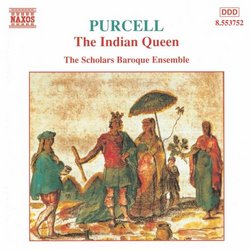Purcell's final masterpiece.
P. M Simon | 12/06/2002
(5 out of 5 stars)
"If we could turn the clock back three hundred years and more, we might be able to enjoy an elaborate entertainment called a masque. The one under consideration here began as a play written by English poet John Dryden and his brother-in-law. Thirty years later, as was often the custom, music for dancing, singing, and orchestral introductions and interludes was added to extend and accompany the original play. Henry Purcell provided the music, which thus transformed "The Indian Queen" from a play into a masque. How could such lengthy and elaborate entertainments be feasible today? Purcell's contribution was all but completed at the time of his death, music for the final section being provided by his brother Daniel. On this fine Naxos CD, all the musical items are performed, extending to almost 80 minutes. The Scholars Baroque Ensemble use period instruments, and its eight vocalists combine for the choral items and individually provide the vocal solo items. Purcell's music is mainly of a two and three part harmonic texture. Just what variety of colour, inflection and expression he could achieve is constantly astonishing. Some of the airs and melodies found here have become well known with different words added. Well-known in its original form, however, is the soprano solo, "I attempt from love's sickness to fly". Also astonishing is the opportunity Naxos provides to have a complete baroque masterpiece performed and recorded with great care, and with notes, a synopsis and a complete libretto thrown in - all for the price of a coffee and cake."
Back before Copyrights
P. M Simon | New Mexico | 05/16/2008
(5 out of 5 stars)
"In the time of Henry and Daniel Purcell, a composer could choose any libretto he wanted, even if someone else had used it already. Another composer could pick up his work, in turn, and graft onto it.
Such was the History of The Indian Queen (actually 'Musik for the Indian Queen'). A mid-17th century masterpiece of the English baroque style, it stands well in comparison to Dowland, Clarke, Morley and such contemporaries.
This work is what's known as a semi-opera. The form was just evolving; pioneered, most scholars agree, by Monteverdi's 1607 L'Orfeo. In fact, The Indian Queen is more reminiscent of the concert suite of L'Orfeo (w. Rodriguez), than of a full opera. The Queen, even with the posthumous-to-Purcell grafting of brother Daniel's The Mask of Hymen, remains a listenable under-80-minutes.
The vocals on this performance and excellent, even if the plot of the libretto is thin and historical nonsense. Period instruments are well-used and well-directed. Quality of the CD is ample. The price is a BARGAIN!
For any fan of the genre, the period, or music history!
"


